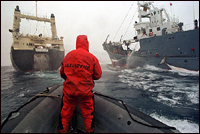At a time when environmental groups are facing questions about their own mortality and rethinking strategies for surviving Dubya‘s second term, Greenpeace USA — the environmental group best known for in-your-face, laws-be-damned direct action — is getting in touch with its inner Gandhi.

Greenpeace rabble-rousing in days of yore.
Greenpeace/John Cunningham.
In the last few years, the group has trained activists for such harrowing and gymnastic acts as scaling the 700-foot smokestack of a dirty Pennsylvania coal plant, ambushing a cargo boat carrying mahogany from Brazil, and battling logging operations in Oregon and the Tongass National Forest in Alaska.
This year’s biggest planned action? A kayaking and trekking expedition through the Arctic. And the goal is not to face off with Exxon folks on oil rigs or shield baby seals from club-brandishing hunters, but to document the magnificent yet melting ecosystem and beam images of it to the Greenpeace website and hopefully beyond.
Some say this represents a softening of tactics. Greenpeace USA Executive Director John Passacantando begs to differ.

John Passacantando.
Greenpeace.
He maintains that a peaceful presentation of compelling images from the threatened Arctic will be a powerful tool. “It’s time to rebuild the base. First you have to help people see that which they love — pristine nature, children — then you can show them the destruction and they can get angry,” he said. “But they need to love it first. The public needs to be inspired to understand why saving green earth and public health matters. We have to speak to their hearts with stories that are dramatic and stunning and beautiful.”
In other words: Time to back off from battlefield tactics and try to win over the hearts and minds of those who’ve lost touch with the values of the movement.
This thinking is right in line with arguments coming out of the “Death of Environmentalism” debate — that environmental activists have fine-tuned the art of scaring the public (and, with prattle about parts per million, boring the public), but still have no grasp of how to inspire the public. It also reflects a growing realization among progressives that a litany of detailed policy prescriptions doesn’t win as many votes as a simple, values-based storyline.
And then there’s the fact that battlefield tactics have brought Greenpeace more trouble during the Bush administration than in previous years. In 2004, more Greenpeace activists faced felony charges than ever in the group’s history, according to Passacantando. In fact, criminal charges were brought against the organization as a whole by John Ashcroft‘s Justice Department in response to a 2002 protest against mahogany shipments from Brazil — an unprecedented government move to quash environmental direct action.
Passacantando doesn’t believe that all the old Beltway strategies of environmental organizations should be thrown out, but, he says, “The current political moment calls for a shift in tactics. We appreciate that there are those in the D.C. trenches fighting the rollbacks, but we believe that ever since Bush has come into office there’s less to be gained there than in efforts to rally the base. … [W]hen you get into an era when the forces of government are aligned against you, then your efforts are best spent elsewhere.”
Even as he steers Greenpeace in a new direction, Passacantando isn’t ruling out the possibility of old-school, down-and-dirty pranks: “If people think we’re going soft, all the better. It’s always good to have that added element of surprise.”

